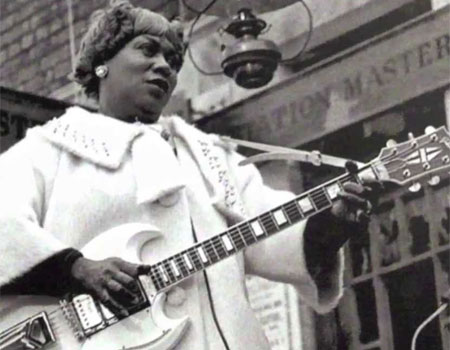
Sister Rosetta Tharpe. She was an early influence on figures such as Little Richard, Johnny Cash, Elvis Presley and Jerry Lee Lewis. A woman whose music runs like a thread through rock’n’roll history: her popular 1940s recording of Up Above My Head – a rousing duet with her friend and lover Marie Knight – provided the template for a 1964 interpretation by Long John Baldry and Rod Stewart
The daughter of Arkansas cotton-pickers, Tharpe was raised by her mother, a travelling evangelist with the Church of God in Christ. She was six years old, and already playing the guitar and performing in church, when they moved to Chicago, where she soon absorbed the sounds of blues and jazz, and went on to attract a following.
In 1938, after a short-lived first marriage, she moved to New York, where the great talent scout John Hammond included her – alongside Big Joe Turner, Big Bill Broonzy, Count Basie and others – in his celebrated From Spirituals to Swing concert at Carnegie Hall. But she also shocked her original fans by appearing at the Cotton Club and singing secular material – some of it, such as Four or Five Times and I Want a Tall Skinny Papa, decidedly risqué. Nevertheless, a song called Strange Things Happening Every Day became the first gospel record to reach the R&B top 10 in 1945; and 25,000 fans paid to attend her wedding to her third husband in a Washington DC sports stadium in 1951.
Her following had once included the young Elvis Presley, who loved her ferocious guitar-playing. Dylan, on his radio show, said of a later British tour: “I’m sure there are a lot of young English guys who picked up an electric guitar after getting a look at her.” Just as remarkable as her guitar-playing is the great artistry of her singing: the strength of her tone and her command of expressive variation, the flexibility of her phrasing, the mastery of vibrato. The headstone erected on her grave decades after her death bears these words: “She would sing until you cried, and then she would sing until you danced for joy. She kept the church alive and the saints rejoicing.” And she helped shape the sound of rock’n’roll.
Listen to her here: https://www.youtube.com/watch?v=JeaBNAXfHfQ



